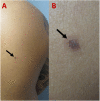Atrophic Dermatofibroma: A Unique Dermatofibroma Variant
- PMID: 34035995
- PMCID: PMC8136451
- DOI: 10.7759/cureus.14570
Atrophic Dermatofibroma: A Unique Dermatofibroma Variant
Abstract
Dermatofibromas are benign skin tumors with several variants, including the rare, uncommonly described atrophic dermatofibroma. To the best of our knowledge, there are currently 105 reported cases of atrophic dermatofibromas in the literature. This variant typically presents as a flat or depressed macule whose color can range from brown to white to red; in contrast to classic dermatofibromas that typically occur on the legs, atrophic dermatofibromas have a tendency to occur on the upper back and arms. An atrophic dermatofibroma can be clinically diagnosed; however, given the broad spectrum of clinical features of this lesion, a biopsy may be required. Characteristic pathologic features include epidermal acanthosis, basilar hyperpigmentation, fibroblast hyperplasia, and decreased or absent elastic fibers within the lesion. The pathogenesis of this lesion is not yet fully understood; however, it has been postulated that the loss of elastic fibers plays a key role in its development and characteristic atrophic appearance. We present the cases of two men with biopsy-confirmed atrophic dermatofibromas: a 47-year-old man with a pigmented macule on the right upper back and a 68-year-old man with an erythematous patch on the left posterolateral shoulder. The clinical and pathologic features of atrophic dermatofibromas are also summarized.
Keywords: acanthosis; atrophic; atrophy; dermatofibroma; elastic; fibers; fibroblast; hyperpigmentation.
Copyright © 2021, Gutierrez et al.
Conflict of interest statement
Philip R. Cohen is a consultant for ParaPRO.
Figures






References
-
- Atrophic variants of dermatofibroma and dermatofibrosarcoma protuberans. Zelger BW, Ofner D, Zelger BG. Histopathology. 1995;26:519–527. - PubMed
-
- Atrophic dermatofibroma and dermatofibrosarcoma protuberans. Page EH, Assaad DM. J Am Acad Dermatol. 1987;17:947–950. - PubMed
-
- Atrophic dermatofibroma: a case report and review of the literature. Hendi A, Jukic DM, Kress DW, Brodland DG. Dermatol Surg. 2002;28:1085–1087. - PubMed
-
- A rare case of atrophic dermatofibroma with dermoscopic findings. Aktaş Karabay E, Demir D, Gürsoy F, Zindancı İ. J Cosmet Dermatol. 2021 - PubMed
Publication types
LinkOut - more resources
Full Text Sources
Other Literature Sources
